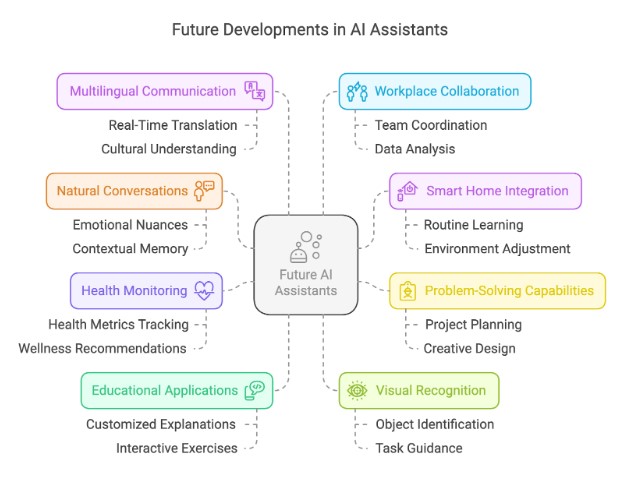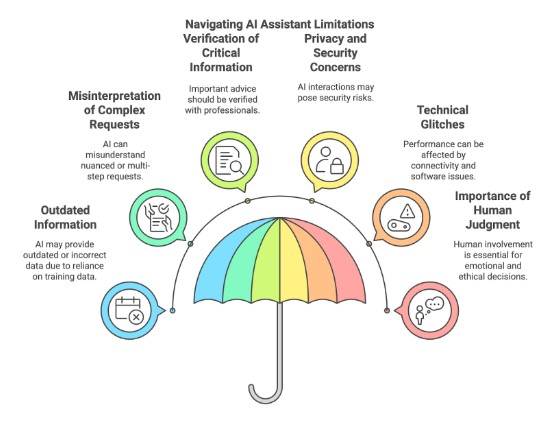“Hey Siri, what’s the weather like today?” “Alexa, set a timer for 30 minutes.” These familiar phrases represent a technological revolution that has quietly transformed our daily routines. AI assistants have evolved from simple voice-activated tools into sophisticated digital companions that seamlessly integrate into our lives. Like having a personal assistant available 24/7, these AI-powered helpers can manage our schedules, answer questions, control our homes, and even anticipate our needs – all through natural conversation.
What makes these assistants truly remarkable is their ability to learn and adapt. They recognize different voices, remember preferences, and become more attuned to individual needs over time. As we shift away from typing commands and pressing buttons, the way we interact with technology is becoming more intuitive and conversational than ever before.
The impact of AI assistants extends far beyond mere convenience. They’re democratizing technology, making complex digital tools accessible to everyone from tech-savvy teenagers to seniors who might struggle with traditional interfaces. By transforming complicated tasks into simple voice commands, they’re creating a more inclusive digital world where age, technical expertise, or physical limitations are no longer barriers to accessing modern technology.
Core Capabilities
AI assistants excel at various tasks that make our lives easier:
Information and Communication
Your AI assistant can answer questions instantly, translate languages in real-time, make calls, send messages, and keep track of your schedule through reminders and alarms. It learns your preferences over time, making interactions increasingly natural and personalized.
Home Automation and Entertainment
Control your smart home devices with voice commands, from adjusting thermostats to managing security systems. AI assistants also act as entertainment hubs, playing music, podcasts, and audiobooks while learning your preferences to make better recommendations.
Shopping and Navigation
Get help with online shopping, package tracking, weather updates, and real-time traffic information. Your assistant can maintain shopping lists, find the best deals, and suggest optimal routes for your commute.
How They Work
AI assistants operate through several sophisticated processes:
- Voice Recognition: They continuously listen for trigger phrases (“Hey Siri,” “Alexa”) and use advanced microphones to isolate your voice from background noise.
- Natural Language Processing: The assistant analyzes your request, understanding both the words and their context to determine your intent.
- Task Execution: Based on your request, it searches databases, controls devices, or performs other actions using specialized algorithms.
- Machine Learning: The system improves through millions of interactions, becoming better at understanding different accents, contexts, and user needs.
 Future Developments
Future Developments
The next generation of AI assistants promises exciting advances:
- More natural conversations with a better understanding of context and emotions
AI assistants will better understand emotional nuances, remember past conversations, and adapt their communication style based on your moods and preferences.
- Enhanced smart home integration with predictive automation
Systems will learn your daily routines to automatically adjust lighting, temperature, and appliances without explicit commands, creating a truly responsive living environment.
- Advanced problem-solving capabilities for complex tasks
Assistants will handle complex tasks like project planning, creative design work, and sophisticated analysis, offering solutions based on vast knowledge databases and pattern recognition.
- Health monitoring and wellness support
Through voice analysis and pattern recognition, assistants will track health metrics, provide medication reminders, and even detect early signs of illness, while offering personalized wellness recommendations.
- Improved educational applications with personalized tutoring
AI tutors will adapt to each student’s learning style, providing customized explanations, interactive exercises, and real-time feedback to enhance learning outcomes.
- Visual recognition capabilities
Future assistants will use computer vision to help identify objects, analyze surroundings, and provide visual guidance for tasks like cooking, repairs, or fashion choices.
- Seamless multilingual communication
Real-time translation will become more accurate and natural, including an understanding of cultural contexts and idioms across languages.
- Enhanced workplace collaboration tools
AI assistants will facilitate team coordination, manage projects, analyze data, and contribute to strategic planning while seamlessly integrating with existing work tools.

Understanding Limitations
While powerful, AI assistants have important limitations to consider:
- They may provide outdated or incorrect information
Assistants rely on their training data, which may become outdated. For example, they might provide old business hours or outdated pricing information if their data hasn’t been recently updated.
- Complex or nuanced requests can be misinterpreted
Complex requests involving multiple steps or subtle context can be misunderstood. For instance, asking “What’s the best restaurant?” without specifying preferences for cuisine, price range, or location may lead to irrelevant suggestions.
- Critical information should be verified with authoritative sources
Medical advice, financial information, and legal guidance should always be verified by qualified professionals. AI assistants should be used as initial reference points rather than definitive sources.
- Privacy and security considerations remain important
Voice commands and queries are processed through internet connections, making them potentially vulnerable to security breaches. Users should avoid sharing sensitive personal information like passwords or financial details.
- Technical glitches can affect performance
Performance can be affected by internet connectivity, software bugs, or hardware issues. Even the most advanced AI assistants require stable internet connections and regular updates to function properly.
- Human judgment remains essential in many situations
Situations requiring emotional intelligence, ethical decision-making, or complex social understanding still need human involvement. AI assistants can’t replace human judgment in sensitive personal or professional matters.
Understanding these limitations doesn’t diminish the transformative potential of AI assistants; rather, it helps us use them more effectively. As these technologies continue to evolve, finding the right balance between leveraging their capabilities and maintaining human oversight becomes increasingly important. By acknowledging both their strengths and limitations, we can better harness their potential while maintaining realistic expectations about their role in our lives.

Conclusion
AI assistants represent a significant advancement in human-computer interaction, making technology more accessible and useful for everyone. As these systems continue to evolve, they’ll become even more capable partners in our daily lives, enhancing rather than replacing human capabilities.
The key to getting the most value from AI assistants is understanding both their capabilities and limitations. Start with simple tasks, gradually explore new features, and maintain critical thinking when evaluating their responses. Every interaction helps improve these systems, contributing to a future where technology better serves human needs.



